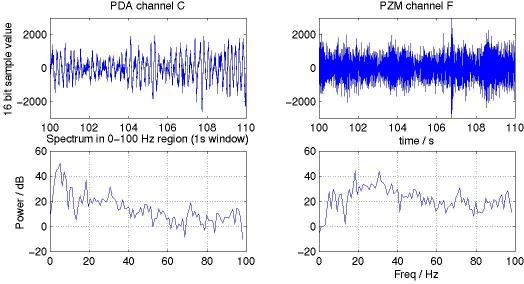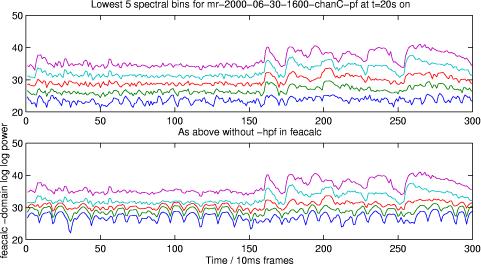As part of the Meeting Recorder project, we have been recording a pair of stereo channels from a mock up of a future PDA that might be used to record meetings. As the noise properties of these signals are quite unusual, this page gives some details. In particular, the PDA mic channels have a very large amount of very low frequency noise.
Because we are interested in what information is available from relatively low-quality microphone recordings, we built a mock-up PDA with two cheap electret microphone elements, and we have recorded from these in all our meeting recorder data collection efforts. The quality of these signals is surprisingly good, subjectively competitive with the $300 PZM mics we are also using. However, it turns out that the signal is degraded in a less obvious way: The pickup of low-frequency rumble (from the airconditioning, and perhaps from people walking around the building) is very high. Before processing, the PDA signals typically have almost all of their energy below 10 Hz i.e. far below the audible range.
The table below shows how the energy is distributed across frequency band for the high-quality PZM and cheap PDA microphones. This is specifically for a 'quiet' section when only the background noise is being recorded.
| Microphone | Energy < 15 Hz | 15-50 Hz | 50-500 Hz | 500-8000 Hz |
|---|---|---|---|---|
| PZM | 35.0 dB | 49.5 dB | 45.4 dB | 41.6 dB |
| PDA | 53.2 dB | 40.0 dB | 33.1 dB | 27.4 dB |
(0 dB here is a 1-bit signal)
Comparison waveforms (from mr-2000-06-30-1600) and the sub-100 Hz spectra are shown below. You can actually see the 5 Hz component in the time domain waveform at this scale. Note the spectral peaks at 18 and 32 Hz in both signals - they are showing much the same response, except below 10 Hz, when the PZM rolls off and the PDA suddenly jumps up.

NB: The amount of VLF noise may depend on whether the airconditioning fan is turned on, so it could vary quite widely across different meetings. I haven't looked enough to know.
The following filter (in Matlab notation) seems quite effective:
y = filter([1 -1],[1 -0.98],x);
That's a zero at 0 Hz, compensated by a pole just inside the unit circle. Its response is 3 dB down at 50 Hz, 20 dB down at 5 Hz, and with negligible effect on the main part of the spectrum.
When doing feature calculation based on the PDA channels, it is important to use the -hpf option to feacalc to use the DC-blocking high-pass filter. As shown below, without this flag, the bottom two spectral channels are seriously distorted, with consequent impact on every cepstral feature:

These show the bottom 5 channels of feacalc's output in log-spectral mode (feacalc -dom log) with (top) and without (bottom) -hpf. As you can see, bottom two channels (of 19) (blue and green traces) are dominated by spillover from the 5 Hz rumble if -hpf is not used.
Back to DAn's Meeting Recorder index - ICSI Meeting Recorder homepage - DAn's homepage - ICSI Realization group homepage